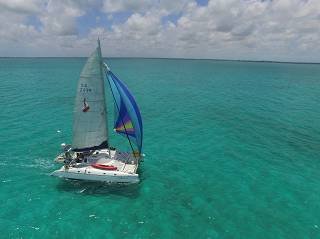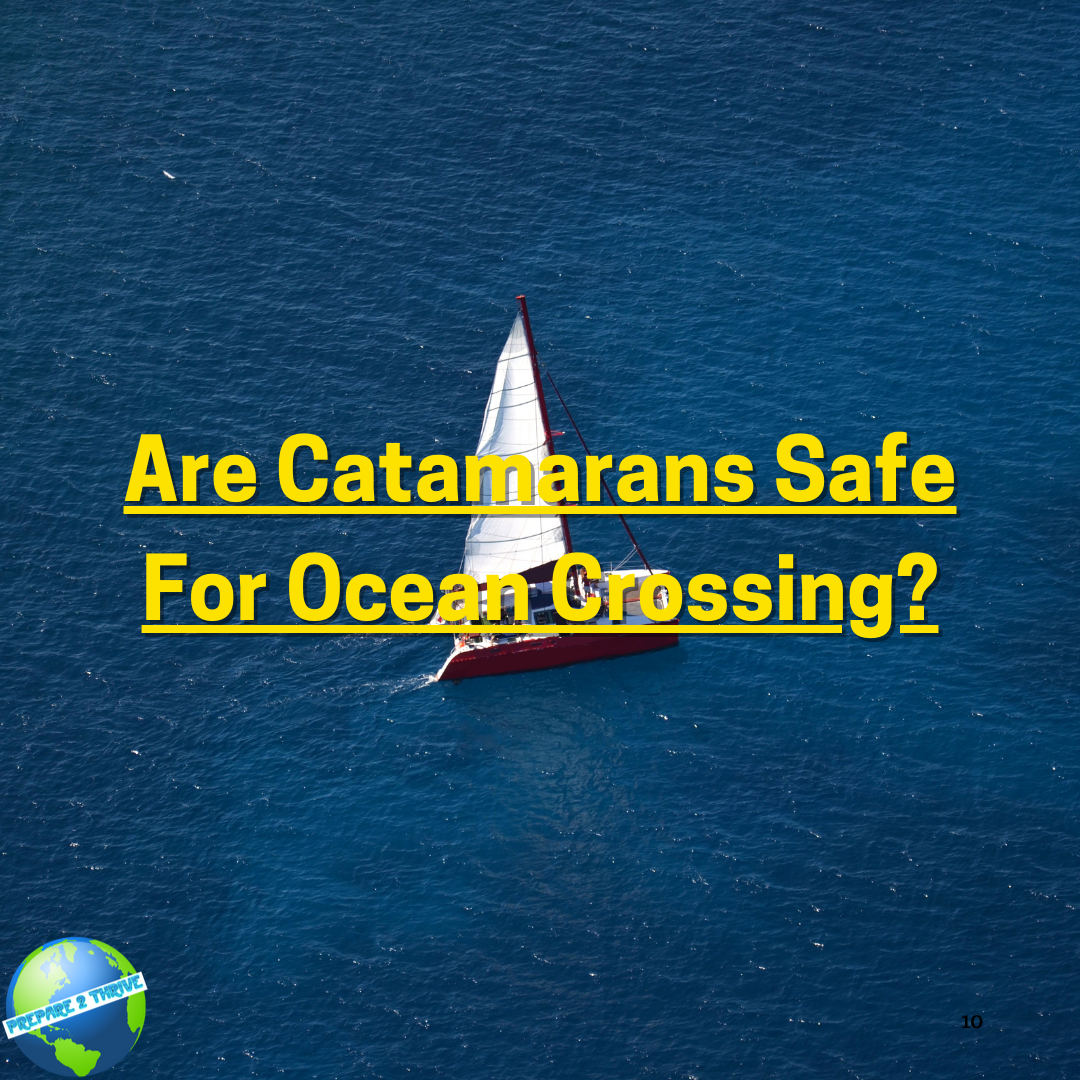Catamarans aren't the most common ocean-crossing sailboats, but they're surprisingly safe and capable offshore.

Catamarans are safe for ocean crossings. In fact, catamarans are often much safer than similarly-sized monohulls offshore. Safety comes from increased motion comfort, great stability, speed, and excess buoyancy due to lack of ballast.
In this article, we’ll examine if catamarans are safe (or safer) than monohulls for offshore cruising and ocean passages. We’ll also examine the benefits of cruising catamaran design, along with how these vessels handle in different offshore conditions.
We gathered the information used in this article from offshore sailing guides and reputable catamaran experts. We also examined design guidelines for offshore cruising boats, including head-to-head tests done between catamarans and other vessels.
Safety of Bluewater Catamarans
Cruising catamarans that are capable of bluewater sailing are some of the safest vessels on the water. In fact, they're often preferred for ocean crossing due to their miraculous speeds and excellent rough-water handling qualities.
Catamarans are uniquely equipped for safe and comfortable offshore sailing. They're not subject to the traditional limitations of hull speed, and they have a mild planing effect which reduces drag and the effects of rough seas.
Safest Catamaran Design for Crossing an Ocean
The safest ocean-crossing category is cruising catamarans, as these vessels include design elements and safety features that aren't found in recreational racing catamarans. An example of this is additional positive buoyancy material and watertight hatches.
Cruising catamarans have high-strength cockpit windows, which are designed to resist damage if a wave crashes on them. They also have redundant systems such as bilge pumps, navigation lights, and radios-which are all essential in an offshore voyage.
In fact, cruising cats are so safe that they're often recommended by expert sailors to more novice individuals. They aren't necessarily easier to sail, but they can handle rough weather safely and with better stability.
This keeps the crew dry and rational while the boat handles much of the ocean's beating all on its own.
Is it Safe to Sail a Catamaran During the Winter?
Catamarans can actually be safer to sail in winter weather conditions than monohulls. This is because cruising catboats almost always have enclosed cockpit spaces that are completely shielded from the elements. This is particularly helpful during the winter, but it's also a great feature in the tropical rainy season.
Catamaran crews can usually pilot their vessels from inside or behind these enclosed cockpits, keeping them warm and dry for as long as possible.
Additionally, given the premium nature of cruising catamarans, many of these vessels have automated winches and sails, allowing complete control from the interior cockpit.
How do Catamarans Handle Rough Weather?
Catamarans handle rough weather well, especially larger vessels with more displacement. But unlike monohull sailboats, draft and displacement aren't the most critical factors when evaluating foul-weather safety.
Catamarans are more difficult to swamp than monohulls. This is because they create a channel between their hulls that acts as a pressure relief valve, thus decreasing the likelihood of a rogue wave pushing the vessel under or knocking it over.
Catamarans are famous for their ability to weather high winds and chop. An equal-sized monohull may be just as strong and seaworthy, but the crew certainly wouldn't be praising its easy-riding qualities after a strong storm.
Catamaran captains are sometimes guilty of underestimating the danger or intensity of storms because a storm that beats the confidence out of a monohull crew may not even spill the coffee off the galley table in a catamaran.
Catamaran Buoyancy
Catamarans also have design elements that make them difficult-or nearly impossible-to sink. Or, to sink completely anyway. It's all about buoyancy, and catamarans have tons of it.
Monohull sailboats can handle well offshore, provided they have a low enough center of gravity and enough displacement to stay upright in violent gusts and large waves. Usually, monohull designers achieve this by working in an extremely heavy and deep ballasted keel.
In other words, offshore monohulls sit artificially low in the water due to added ballast for stability, both inside the cabin and deep in the keel. This is great until something starts to throw off-balance, like a bunch of water in the cabin.
Catamarans don't sit very low in the water because they're much more buoyant than monohulls and carry no large keels or ballast.
On their own, catamaran side hulls would probably roll over due to their lack of low ballast. But when strung together, they balance each other out and keep the hull far out of the water.
Catamarans don't often sink because they're simply too buoyant. They use their width and dual hulls to make up for the lack of ballast.
Plus, catamaran builders sometimes add additional positively buoyant material such as foam, to the point where sinking an intact vessel would be utterly impossible.
Are Catamarans Strong Enough for Ocean Sailing?
All production bluewater catamarans are extremely rigid and structurally sound. Catamarans make ocean journeys all the time and suffer tremendous stresses, which monohulls never experience. As a result, they're built using stronger materials and reinforced in all necessary areas.
Do Catamarans Break in Half?
It seems easy enough to believe-a catamaran hits a funny wave and breaks in half. After all, catamarans are only held together by a thin strip of fiberglass, right? Wrong-catamaran design is very robust, and all production catamarans are thoughtfully designed and strong.
Apart from the odd story in a sailing magazine, catamarans rarely just break in half. There have been some cases of it happening, but only due to extreme conditions, specific design flaws, or shoddy amateur construction.
Catamarans hulls break off far less often than regular monohulls sink-often in much less hazardous conditions than the few catamarans that did break in this way. So no, you don't have to worry about a production catamaran breaking in half while on the ocean.
Catamaran Comfort and Safety
Comfort can actually be a safety benefit on the open ocean, especially when sailing with a limited crew. Catamarans are known for their stability and increased motion comfort, which can improve the overall health and ability of the crew.
Think about it this way. A seasick and exhausted crew won't be able to deal with navigation or emergencies as efficiently and safely as a well-fed and well-rested crew. This is one of the indirect benefits that offshore catamarans have above most traditional monohull designs.
Catamaran Roll Safety
What happens if a catamaran suffers a knockdown? Usually, nothing good-catamarans can't self-right after a knockdown, unlike some monohulls with a low center of gravity. You're much more likely to have a knockdown or nail-biting roll on a monohull than a catamaran.
That said, catamarans don't suffer knockdowns nearly as easily as similarly-sized monohulls. This is because catamarans distribute their weight widely, and they have a much greater natural roll resistance.
Catamarans have great buoyancy in some parts of the hull and minimal buoyancy in others, which can actually increase roll resistance. For example, catamarans can slice through waves instead of riding over the crest and rolling violently.
It's not easy for the wind to push a catamaran down-quite the opposite. Catamarans actually rise out of the water slightly when sailed properly, even at angles perpendicular to the wind. Catamarans tend to increase in speed as wind speeds increase, directing more energy forward instead of to the side.
Monohulls have completely different high-wind handling characteristics. At some wind angles, high winds can push a monohull dangerously to one side. This is distinct from normal heeling, as the water can begin to rush over the deck and swamp the single-hull vessel.
Can Catamarans Survive Flooding?
Catamarans benefit from another safety feature that's not necessarily a design choice but a design element nonetheless. Catamarans are essentially compartmentalized, and they have a center cockpit high above the waterline.
These characteristics increase the amount of flooding necessary to seriously endanger the vessel. For example, a small leak in one hull needs to be fixed promptly-but it doesn't endanger the boat nearly as much as the same leak in your only hull.
Additionally, much of a catamaran's interior space is in the center console, which is above the waterline and thus can't be flooded from the hulls. Or at least not immediately. This is one of the reasons why catamarans rarely sink.
Catamaran Safety Equipment
Catamarans have a large amount of flat, open space between the hulls. These areas are useful for stowing equipment such as high-tech covered life rafts.
A small boat may have to make do with a small life raft and limited emergency supplies, yet a catamaran can store safety equipment for much larger vessels.
Catamaran Speed
Speed is an important and often overlooked aspect of safety, and we can use an example to demonstrate why. Picture two boats somewhere between Florida and the Bahamas. Dark clouds begin to form overhead, indicating a possible afternoon thunderstorm.
Boat A is a catamaran with good speed and sea keeping abilities. Boat B is a heavier monohull of the same length but greater displacement and technically better seaworthiness.
The catamaran, Boat A, deploys full sail and makes a speed of about 15 knots to outrun the forming storm. Boat B is a monohull and can't make more than 8 knots, even in the best conditions.
Boat A makes it back to port with time to spare, but Boat B is well out to sea taking a beating from the storm. Speed means safety in many situations, even though it's never smart to try and beat the weather if you can stay in a safe location instead.
